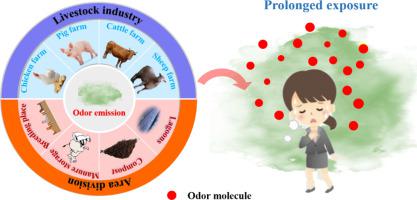Science of the Total Environment ( IF 9.8 ) Pub Date : 2021-02-09 , DOI: 10.1016/j.scitotenv.2021.145735 Yong-Chao Wang , Meng-Fei Han , Ti-Pei Jia , Xu-Rui Hu , Huai-Qun Zhu , Zhen Tong , Yu-Ting Lin , Can Wang , De-Zhao Liu , Yong-Zhen Peng , Gen Wang , Jie Meng , Zeng-Xiu Zhai , Yan Zhang , Ji-Guang Deng , Hsing-Cheng Hsi

|
Odor emissions from intensive livestock farms have attracted increased attention due to their adverse impacts on the environment and human health. Nevertheless, a systematic summary regarding the characteristics, sampling detection, and control technology for odor emissions from livestock farms is currently lacking. This paper compares the development of odor standards in different countries and summarizes the odor emission characteristics of livestock farms. Ammonia, the most common odor substance, can reach as high as 4100 ppm in the compost area. Sampling methods for point and area source odor emissions are introduced in this paper, and odor analysis methods are compared. Olfactometers, odorometers, and the triangle odor bag method are usually used to measure odor concentration. Odor control technologies are divided into three categories: physical (activated carbon adsorption, masking, and dilution diffusion), chemical (plant extract spraying, wet scrubbing, combustion, non-thermal plasma, and photocatalytic oxidation), and biological (biofiltration, biotrickling, and bioscrubbing). Each technology is elucidated, and the performance in the removal of different pollutants is summarized. The application scopes, costs, operational stability, and secondary pollution of the technologies are compared. The generation of secondary pollution and long-term operation stability are issues that should be considered in future technological development. Lastly, a case analysis for engineering application is conducted.
中文翻译:

畜牧场的排放,测量和气味控制:综述
集约化养殖场的气味排放由于对环境和人类健康造成不利影响而引起了越来越多的关注。然而,目前缺乏关于畜牧场气味排放的特征,采样检测和控制技术的系统总结。本文比较了不同国家气味标准的发展情况,并总结了牧场的气味排放特征。氨是最常见的气味物质,在堆肥区可以达到4100 ppm。介绍了点源和面源气味排放的采样方法,并对气味分析方法进行了比较。嗅觉计,气味计和三角气味袋法通常用于测量气味浓度。气味控制技术分为三类:物理(活性炭吸附,掩蔽和稀释扩散),化学(植物提取物喷雾,湿式洗涤,燃烧,非热等离子体和光催化氧化)和生物(生物过滤,生物滴滤和生物洗涤)。阐明了每种技术,并总结了去除不同污染物的性能。比较了技术的应用范围,成本,操作稳定性和二次污染。二次污染的产生和长期运行稳定性是未来技术发展中应考虑的问题。最后,进行了工程应用案例分析。和生物(生物过滤,生物滴滤和生物洗涤)。阐明了每种技术,并总结了去除不同污染物的性能。比较了技术的应用范围,成本,操作稳定性和二次污染。二次污染的产生和长期运行稳定性是未来技术发展中应考虑的问题。最后,进行了工程应用案例分析。和生物(生物过滤,生物滴滤和生物洗涤)。阐明了每种技术,并总结了去除不同污染物的性能。比较了技术的应用范围,成本,操作稳定性和二次污染。二次污染的产生和长期运行稳定性是未来技术发展中应考虑的问题。最后,进行了工程应用案例分析。二次污染的产生和长期运行稳定性是未来技术发展中应考虑的问题。最后,进行了工程应用案例分析。二次污染的产生和长期运行稳定性是未来技术发展中应考虑的问题。最后,进行了工程应用案例分析。



























 京公网安备 11010802027423号
京公网安备 11010802027423号